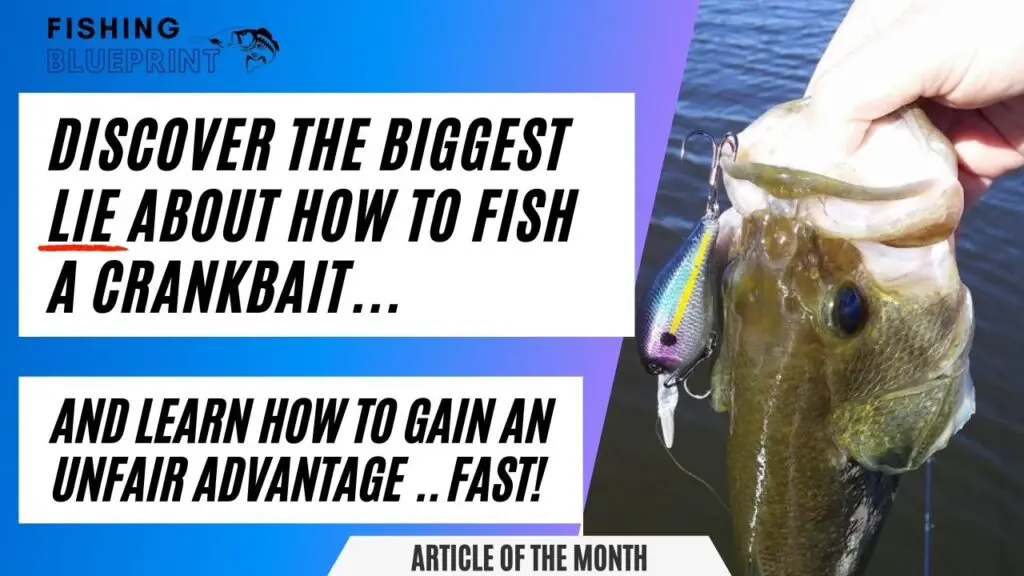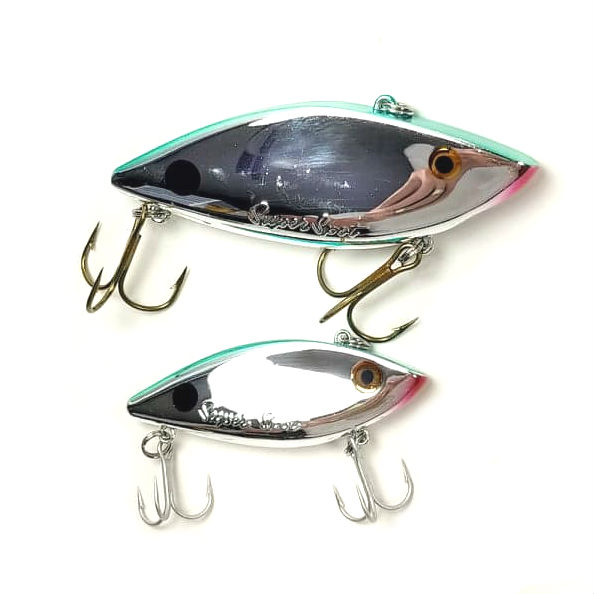What is a crankbait... and... what are the different types of crankbaits?
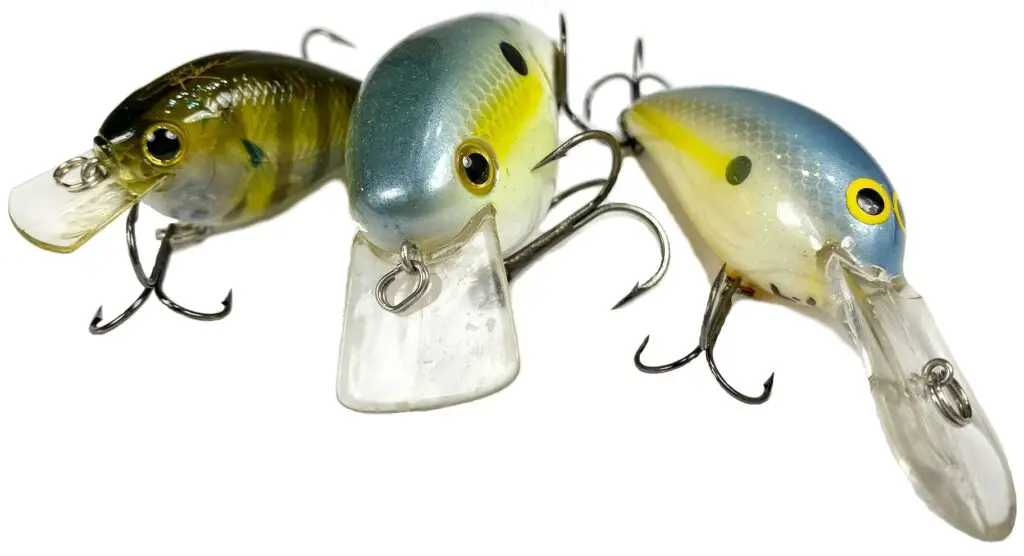
In today’s world of bass fishing being able to use a crankbait isn’t just a recommendation, it’s a necessity. For those who are new to bass fishing it can be overwhelming to learn about all the different styles of crankbaits and where they fit in your arsenal.
Some of the common questions that I’ve been asked (and to be honest I’ve asked myself) was what exactly is a crankbait? What is the best kind of crankbait? What are the different styles of crankbaits? And, what’s the best size crankbait for bass?
Key Takeaways
For most anglers learning what is a crankbait, and understanding what are different types of crankbaits can seem pretty exciting, yet somewhat intimidating. Here is a quick and easy to follow list to help you get started fast!
- The easy answer: is a crankbait is a popular fishing lure made from various materials, in the shape of a baitfish or crawfish, which may include one or more hooks, and may or may not include a diving bill, and lastly will include something to tie your fishing line to.
- Crankbait types are separated into three easy to understand categories. Diving depth, sound produced, and if the crankbait is lipped or lipless.
- Diving depth – Crankbaits are classified as: wake baits, shallow divers, medium diving, deep diving, and extra deep diving crankbaits.
- Sound production – Crankbaits are made to make a sound is called “rattling”, or if the crankbait is made to stay quiet it’s called “silent”
- Lipless crankbait – Lipless have their own category.
- And much, MUCH, more!
If you’re going to learn what is a crankbait its also important to know that some crankbait come in many different sizes, shapes, and colors.
Some are as small as a bean, and some as large as you’re hand is long! They can be thick, or thin, and tall or narrow.
Additionally, some have rattles and some are silent. Some swim shallow, and some can dive to deep water.
Some are painted to look like natural prey, whereas other are painted with wild bright colors!
But listen, if you already know what all the different types of crankbaits are, but really want to know exactly how to fish them, then click here! This will link you over my report where I ethically stole as many crankbait fishing secrets from the pros I could find, furthermore, I tell you all of my proven techniques that have worked for me over the years!
But I digress… Crankbaits are lures that can be used all year long.
There are so many variations of crankbaits it makes this class of lures incredibly popular for bass fishing.
Unfortunately, not every type of crankbait will work in every situation. You, the angler, have to determine what type of crankbait will work the best.
Fortunately for you, this report is going to tell you all about the different types of crankbaits, when to you them, and more importantly when to avoid using them.
Basic Crankbait Anatomy
Crankbait Construction
Crankbaits can be produced from one of three basic materials. Both have their benefits and drawbacks.
Wood
Generally speaking, lighter, high-buoyancy (or fast floating) woods are preferred for making crankbaits. The best woods for making crankbaits include balsa, pine, cedar, white cedar, and basswood. Although more challenging to carve, harder woods like maple, oak, ash, and walnut make great suspending lures and large swimbaits.
The Positives
Balsa baits have an insane amount of action and can grind, float, and hunt far better than any other type of crankbait. For example, squarebill crankbaits are frequently made from balsa wood. The wood optimizes the irregular action of a squarebill crankbait and gets the bait to hunt (action where the lure will swim far to the right and left as if searching for food.
Balsa squarebills can also rise quickly over cover and normally have a very tight action. The best advice I can give is to fish them quickly and force the bait to deflect off cover to elicit reaction strikes.
Helpful tip: "There is nothing better than a balsa crankbait for deflecting off of cover."
The Bad
The negative aspect of wooden baits is the issue of possible irregularity. Wood is a natural product and can have small differences in density.
If you make or buy some wooden baits, you quickly find out that some have fantastic action, and some don’t, especially if the lure is handmade. Fragility is another concern. If you slap the balsa bait on the water there is a strong tendency to break. If you’re hung up and you tug on the bait your hardest you may end up pulling out the line tie wire.
Plastic Crankbaits
The majority of modern crankbaits are constructed from ABS plastics. Though they all offer the same benefits, plastics come in many different varieties.
The process of creating a high-quality hard plastic crankbait, however, is not straightforward and involves a number of difficult procedures.
The two body halves are initially created by injecting hot plastic into a mold, followed by the loading of the interior parts, which include the weights, rattles, hook hangers, and line ties.
Both halves are then chemically fused together to create a watertight seal, and tested for any leaks or signs of moisture retention.
Helpful tip: "Plastic crankbaits put out more sound than wooden crankbaits are great to fish for bass in the summer and early fall. "
Hard plastic crankbaits are generally cheaper and easier to make. Since the process is so automated all the baits are uniform in terms of weight, balance, sound, and wobbling action.
Although plastic baits are considered to be more durable they have considerably less hunting and deflecting action than do the wooden counterparts.
Composite Crankbaits
Some crankbaits are created from high-density foams or PVC material decking material.
PVC decking material such as AZEK PVC Trim Boards materials are most commonly utilized by custom crankbait makers (including myself) and is a relatively new material to make baits within the last 10 or so years.
There are plenty of reasons why anglers are using this material over something like balsa.
It is 100 percent waterproof. Making a lure, testing its buoyancy, and ballasting it without any sealing is simple. I practice exam floating in a 3 gallon pail of water in my driveway.
It floats. Knowing plenty of bait makers that now use the Azek PVC decking trim board material compare it to the hardwood poplar on both weight and ease of carving. Additionally they say is floats about as good (if not better) than a medium density balsa bait made the same way.
It’s strong. For the purpose of making lures, the decking is as durable as any other wood, and the trimboard, although not being as dense, is still more than capable of supporting any crank. Additionally, the PVC material will not only make any size crankbait, but you can also make jointed lures.
The PVC decking has enough strength to prevent the screw eyes being pulled out, just simply make a little pilot hole and twist in the screw eye. No need for epoxy-filled holes or reinforcing of any kind.
It cuts, carves and sands really well. PVC is easily sanded into the correct shape. No special tools needed, you can use the same equipment you would use for wood baits.
Sharp tools are ideal when carving details. Surprisingly t carves incredibly nicely with sharp tools because it lacks direction-oriented grain.
Using the same PVC adhesive plumbers use for PVC pipe or super glue, it may be fused into larger lure blanks. The two components really melt into a single, solid piece when the glue and PVC primer are used together.
Painting PVC is easy. Lure makes never complain about any paint-body separation issues when use common white airbrush paint as a base coat, especially after they heat set it.
Any finish will do. Epoxies, urethanes, and concrete sealers have all been utilized by me and other lure makers without incident.
Simply said, using PVC composite decking makes lure making quicker and simpler, which makes it even more enjoyable, which is why I use it and so many other bait makers.
Bill Design
Most crankbaits have a firm, flat and thin structure extending out from the nose of the bait. This is called the ‘bill’.
The bill can be made from clear ABS plastic, circuit board, carbon fiber, or metal.
Crankbait bills have a couple of different functions.
- First, they allow the bait to dive to a specific depth.
- Second, they assist in giving the bait its lifelike movement.
- Third, the bill will cause the bait to deflect off submerged structure and prevent it from getting hung up.
Helpful tip: "The diving depth is mandated by the overall length of the bill and where it’s attached to the lure."
Unfortunately, it’s impossible to accurately tell how deep a crankbait will dive just by looking at the bill. However, the deepest running crankbaits the bill will be straight/parallel to the body.
In contrast, the shallowest running crankbaits will have a bill that is more downward angled.
In general, the wider the bill the wider the wobble.
Most crankbaits will have some sort of bill, while others do not.
The ones that do not are called ‘lipless crankbaits’, we’ll talk about those later. The others will be designated into diving depths; ‘shallow’, ‘medium’ and ‘deep’.
Sound
All crankbaits will have a belly weight. This is built into the bait to help it swim in an upright and natural position. Some crankbaits will have extra rattles or loose-fitting weights that will double as rattles.
The sound created from the crankbaits will resonate through the water and will catch the attention of the bass.
Helpful tip: "Most internal rattles will be made from steel or lead. Other options can include tungsten or glass rattles."
Some other crankbaits will not have rattles. They are called ‘silent’ crankbaits.
Silent crankbaits are for special conditions such as when the bass are very shallow (like during spawn), if the bass are highly pressured, or if the lake is very clear.
Crankbait Hooks
The last thing you will notice about crankbaits is that there are usually two sharp treble hooks hanging from the bottom of the bait.
These treble hooks are the business end of the lure and catch the fish, but they also act as an additional weight to help the keel that is designed into the lure. It will further help the lure swim straight.
For newbies, looking at those treble hooks one can only ascertain that it will hook itself on the first piece of structure or wood it swims over. But fear not, the bills will often deflect the bait over the wood and cause it to not get hung up.
Shallow Diving Crankbaits

Shallow diving crankbaits refers to lures that dive four or less feet of water.
One of the defining characteristics of the shallow diving crankbaits is that the line tie is at the nose of the bait and the plastic bills are shorter and more vertical relative to the horizontal position of the body of the lure.
This forces the lure to swim at the shallow depth and will have a wider wobble.
Shallow crankbaits are ideal for fishing in these areas:
- Spawning flats
- Shallow rock
- Submerged grass beds
- Laydowns near the bank
- Tops of standing timber
- Docks
- Bridge pilings
- Floating harbor tires
Choose a crankbait with a wider bill like a squarebill crankbait, such as the Lucky Craft 2.5, Strike King Squarebill or even a balsa bait like the Bagley Balsa B2.
The wide bill forces the bait to roll over the branch and avoid getting hung up.
Importantly, shallow diving crankbaits are great for schooling bass that are feeding in the top of the water column, creating ‘shad boils’.
Throw past the shad boil and retrieve through it. Opportunistic bass will hammer this shallow running lure.
Are Medium Diving Crankbaits Any Good?
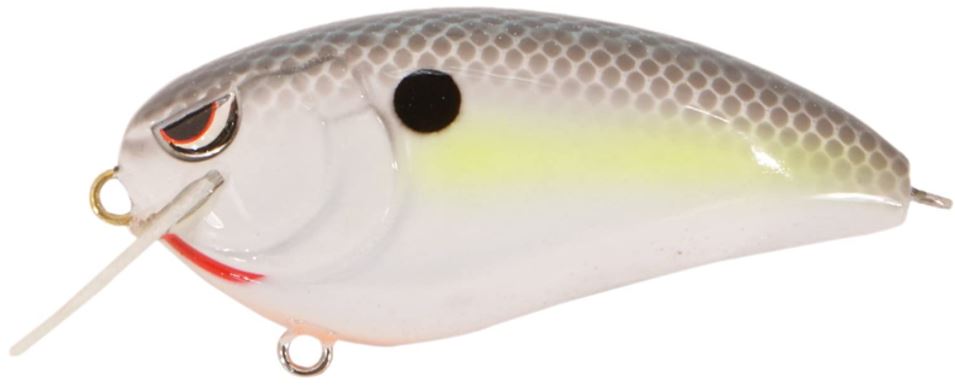
Medium diving crankbaits can be defined as baits that dive approximately 6–12 feet of water. It’s always good to have a solid selection of medium diving baits.
Many fish will either wait at that depth waiting to ambush fish higher in the water column or deeper dwelling fish will move up to that depth to actively feed.
Medium diving crankbaits are ideal for fishing in these areas:
- Along shaded sides of vegetation
- Along shaded sides of a steep shoreline
- Parallel to a rip rap dam
- Shell beds.
- Standing timber
- Outer and inner bends of channel swings
Deep Diving Crankbaits
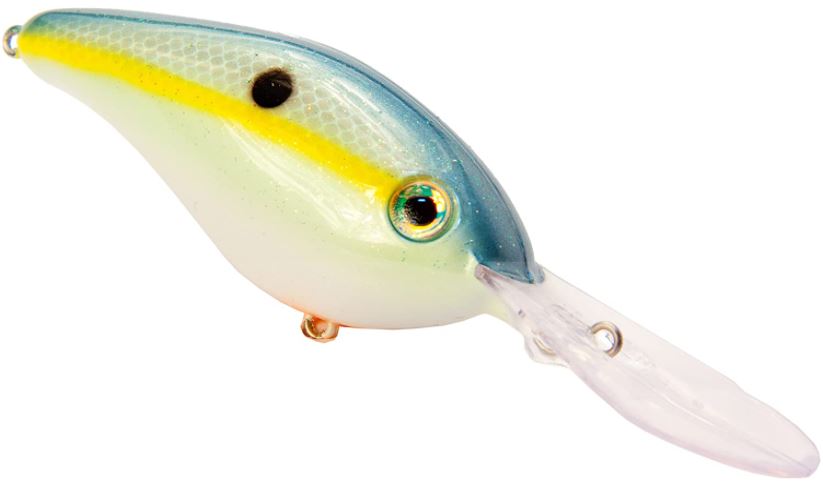
Deep diving crankbaits are big and heavy and have 3 to 5 inch bill lengths. I like to fish my deep diving crankbaits on fluorocarbon 10-15-pound test line.
Fluorocarbon sinks, cuts through the water, it’s nearly invisible to the fish and best of all it’s not stretchy like a monofilament line.
Helpful tip: "Fishing with monofilament can sometimes feel like your fishing with a rubber band because the line is so stretchy. This makes for bad hook sets!"
Cast out the bait as far as you can. Owning a rod specifically made for crankbait fishing will give you extra casting distance, improved diving depth, and better hooksets.
Drop your rod tip and keep pointing it down to enhance the dive angle.
You also need to have a good selection of deep diving baits.
Some deep diving crankbaits will contain rattles and others that are silent running. Sometimes a school may scatter and spook when they hear a loud rattling bait, so it’s important to then switch to a silent running bait.
Make sure to have all your bases covered by investing a few of each.
During the summer the majority of the time of the bass will be holding over deep structure, but above the thermocline. Yeah, they may come up in the shallows to feed for a short time, but the moment the sun crosses over the treeline the fish will move deeper.
So finding deep structure and thermocline is incredibly important if you’re fishing during the late morning or afternoon.
Helpful tip: "If you do not know how to adjust your graph to find the thermocline, simply take note of the depth of where the majority of baitfish are holding at. The thermocline line will be a few feet below them. "
One of the best strategies of fishing for deep summer bass is to make contact with the bottom structure the bass are relating to.
Undoubtedly you want to burn that crank over that structure as fast as you can. Force the bass to make a split decision to either attack your bait or possibly go hungry. Doing this creates monster reaction strikes.
But Where To Fish Deep Diving Crankbaits?
We thought you never ask! Here are some great places to fish that deep diving crankbait.
- Bluff ends
- Main lake humps
- Main lake points
- Deep channel swings
- Ledges dropping off into the old river channel
- Rock piles
- Bases bridge pilings
Fat vs Skinny Crankbaits
How to Select The Best Crankbait? - Width & Wobble
The width of the crankbait is directly proportional to how wide the crankbait wobbles.
The wider the crankbait, the wider the wobble whereas; the narrower the lure, the less wobble.
This is important to point out because seasonal temperature and water clarity will help you choose between a wide wobble lure versus narrow wobble.
It’s also important to determine how wide you want the lure to wobble. The best rule of thumb is that higher the temperature the wider the wobble.
Bass are more susceptible to lures with greater action during the hot summer months.
In the winter months, bass like to save as much energy as possible and, will not chase down a high action lure.
Also if the water clarity is low choose a lure with a wide wobble, the bass can feel the pulsations on the lateral line. This will help with track down and attack the lure with efficiency.
Be aware if the lake is highly pressured or if there was a tournament a day or two before you arrive consider using a silent crankbait.
Other Different Types of Crankbaits
People typically think crankbaits just come with or without lips, and that this doesn’t matter so much as long as there’s a recognizable swimming wiggle as it’s pulled through the water.
However, from here crankbaits can be placed into quite a few sub-categories based on things like use, action, and physical appearance.
Unfortunately, there really isn’t a name for all these sub-categories, but you can usually tell what the main purpose of a lure is on the packaging.
For simplicity, we’ll say there are only three “types” of crankbaits: floating/diving, lipless, and minnow.
Lipped Crankbaits

Easily recognized, “lipped” crankbaits typically have a diving lip carved into the nose of the body or as a plastic bill added to it.
When you’re retrieving the lure, that lip pushes against the water, causing it to dive while producing a wiggle action.
Buoyancy is another part of a lipped crankbait. The level of buoyancy differs greatly; some may float quickly, some suspend, or even sink when left loose in the water.
The purpose of a “floating” crankbait is to counteract the dive, swimming along with their tails higher than their nose. This helps to reduce snags and hang-ups by hitting obstacles with the nose of the lure first, and bouncing off more easily.
With suspending or sinking lures, you’ll be able to get a lot deeper and into those strike zones. The draw-back is obviously the higher likelihood of snags and losing your lure.
Typically if you’re fishing in water with dense cover, you don’t need to be diving so deep anyway.
Lipless Crankbaits
Lipless crankbaits lack the diving lip and typically sink a lot quicker to get down to those strike zones.
Another difference with lipless crankbaits is that they use their slim shape and flat sides to create a swimming action instead of a lip.
Furthermore, the line connection is located on top of lure as opposed to the nose.
This is to aid in producing that swimming action.
The performance of a lipless crankbait is found in the action produced, which is a strong vibrating action.
The vibrating action results in a very tight wobble rather than a wide swimming action seen with diving or floating crankbaits.
The purpose of this vibration is to create high-frequency sonic waves replicating the waves produced by baitfish.
Generally, the faster you retrieve the bait, the stronger the vibration will be.
With the lack of a front bill, you can retrieve a lipless bait much quicker, increasing that vibration.
Interestingly, you’ll also notice similar characteristics with “blade baits” which we’ve considered to belong in this category as well.
Minnow Style Crankbaits/ Jerkbaits

This versatile bait can be twitched, trolled, cranked, suspended or even fished top-water.
Typically “minnow-style crankbaits” also known as jerkbaits are more slender, have a very small diving lip, and produce a slow-rolling action.
Unlike floating/diving crankbaits, the lips on minnow crankbaits are only about 1/8 to 1/4 the size of the bait’s body, making it impossible to dive to deeper depths.
The lips on minnow crankbaits were originally added to aid in creating a swimming action, while allowing it to perform just under the top of the water.
Some manufacturers have started to design the lips to help them run deeper into deep water strike zones.
The body of the bait is also being modified to mimic floating, slow rising, and suspending versions.
The idea is that the suspended minnows can sit at one level near cover, mimicking a real baitfish.
The slow-rising versions haven’t yet been perfected though, and tend to snag quite easily.
However, this is preferred by some anglers.
We’ve seen people add weights to the tails of their minnows to give it a wounded fish look (nose up/tail down).
More Crankbait Articles Just For You...
- What is a Crankbait? [A Complete Beginners Guide with Pictures]
- How To Fish A Crankbait [17 Essential Secrets To Catching Bass With A Crankbait]
- 15 Surefire Ways To Know Exactly What Crankbait Color Works Best… Even If You Have Little-to-no Fishing Experience!
- 15 Surefire Ways To Know Exactly What Crankbait Color Works Best… Even If You Have Little-to-no Fishing Experience!
- Best Crankbait For Shallow Water [12 Baits You Need In Your Tackle Box]
- Best Deep Diving Crankbait [Our Top 20 Baits For ANY Budget]
- Best Jerkbaits for Bass 2023: Top Picks the Pros Refuse to Talk About
- Buyer's Guide To Choosing LIPLESS Crankbaits - Bass Are TERRIFIED!
- Are Crankbaits Good In The Fall? [Little Known Ways to Get More Bites]
- How To Catch 10x Deep Water Bass Using This Little Known Lipless Crankbait Modification
- Where To Buy A Crankbait Rod and Reel Combo (And Get The Best Prices!)
- Best Crankbait Rods Under $100? (And Which I’d Buy On A Budget!)
FAQ
What Are The Best Crankbait Colors?
When selecting a crankbait you must take into account the season/water temperature and water clarity.
Bass will forage on different bait at different intervals throughout the year. Make sure you become familiar with your home body of water or call a few of the local tackle shops in the area.
Most of the time, shad, crawfish, and bluegill patterns work great.
But be warned! … There are certain times specific color patterns will work better than others. And you must know when and where the best crankbait colors will out perform others.
That is why an entire report was dedicated to this exact subject…
How To Fish A Crankbait Exactly?
Now that you have everything you need to start crankbait fishing, it’s time to actually start fishing!
Luckily, fishing crankbaits are fairly simple. Many tournament pros call crankbaits “training wheels” because they are easy to fish.
But there is so much more that just casting it out and reeling it back.
Despite the negative connotation by some, nearly all serious anglers will have a large selection of crankbaits.
What the pro’s don’t want you to know is exactly how to how to fish a crankbait.
Many don’t know there are some specialized considerations on how to fish crankbaits.
Again, a comprehensive report was made addressing this subject.
Where to Find Deep Bass During the Summer Months?
The best tools that can help you are having a good sonar graph and a detailed lake map. Your lake map can guide you to potential targets that should yield fish.
If you know the area that your fishing has good morning action look for deep ledges, creek channels and structure 100 to 200 yards from the shallow feeding grounds.
Long points with deep structure nearby that are attached to the main lake is a high percentage area.
Once you’ve identified potential locations on your lake map use your sonar to further identify “the sweet spot” of those locations.
Irregularities of the on the shoreline often look the same under water. Specifically, when the shoreline changes from small rock to medium sized boulders.
Try locating something different with the general area such as a large boulder in an area of small chunk rocks or a submerged tree in an area that typically does not have any trees.
If your area does not have any differentiating characteristics then use the lines created by that areas items.
Such as, if the area in question is a large deep grass bed then target the edges of the grass bed, particularly the areas that form a point.
More articles just for you...
Funny Fishing Rules, Laws, and Regulations 2025
Crazy Fishing Laws That Will Blow Your Mind! #7 is INSANE! Strange Fishing Regulations and Laws As silly as hook and rod limits may seem,
EXPOSED! How To Use A Spinnerbait The Right Way for 2025
Are You Wondering How To Use A Spinnerbait? Or How To Work A Spinnerbait Over Grass, Logs, or Points? Well, All These Questions Are Answered
EXPOSED! Best Crankbait Colors for 2025 [Which to Buy & Avoid]
What color crankbait to use? Crankbait Color Chart I just love going into a Bass Pro Shops store and just staring at all the walls
Best Underwater Dock Lights For Fishing – 2025 Buyers Guide
Night Dock Light Fishing For Beginners Dear fellow angler, Does this sound like you? You’re someone who loves fishing but just wants to escape the
15 Best Deep Diving Crankbaits [2025 Buyers Guide – Which to Buy & Avoid]
A Complete Buyer’s Blueprint On The Best Deep Diving Crankbaits for Bass, Walleye, or Striped Bass On The Market Today Fishing deep diving crankbaits can
